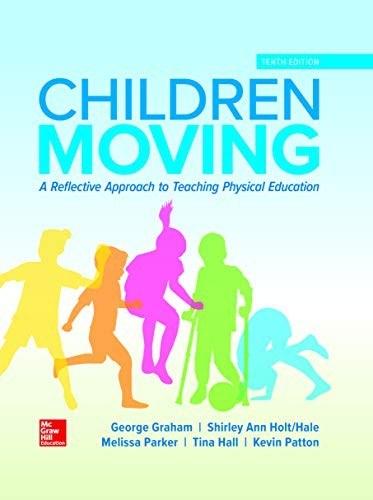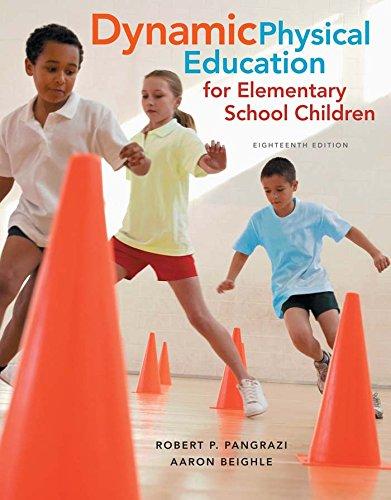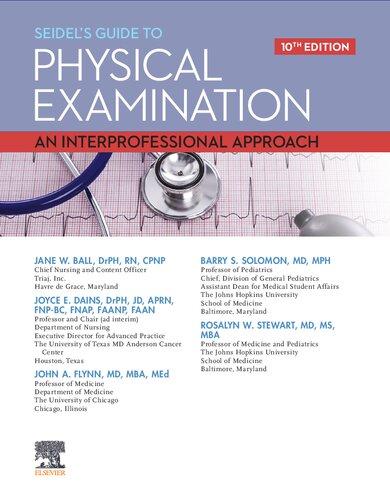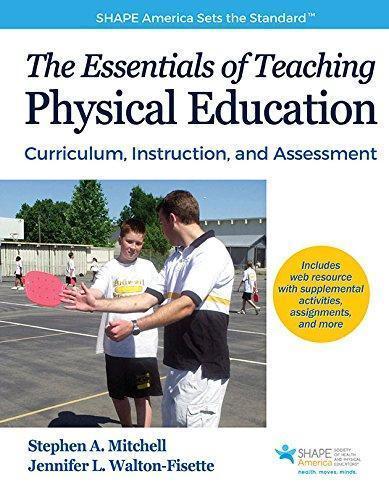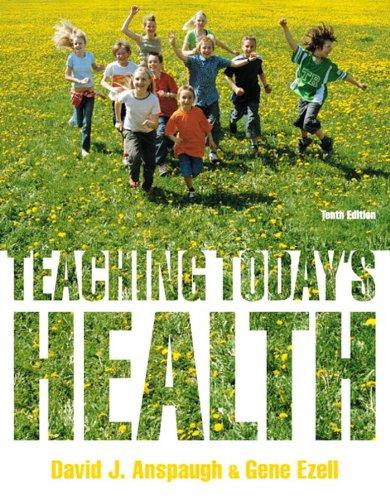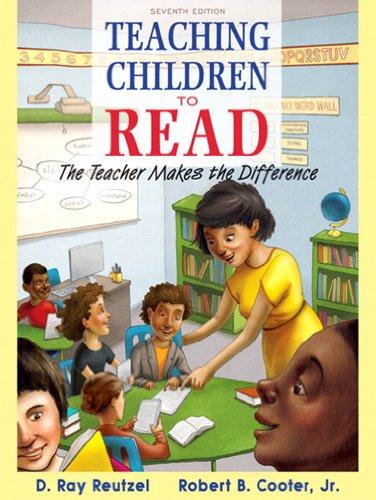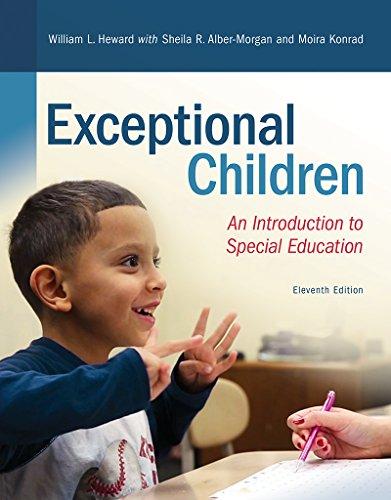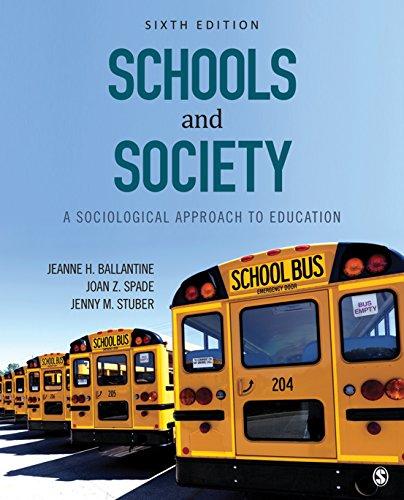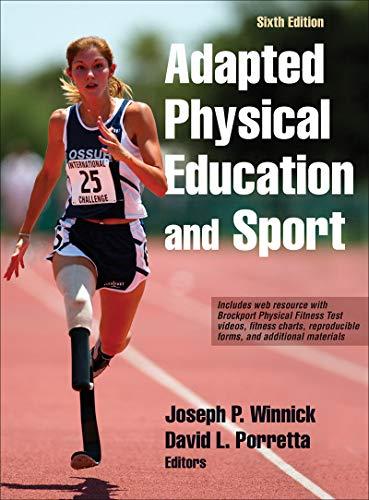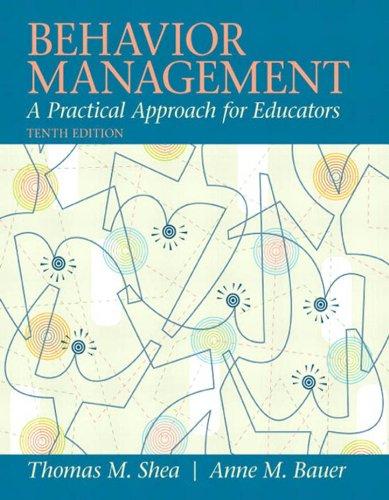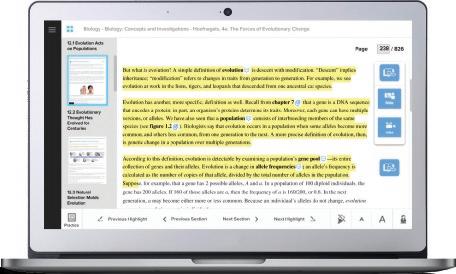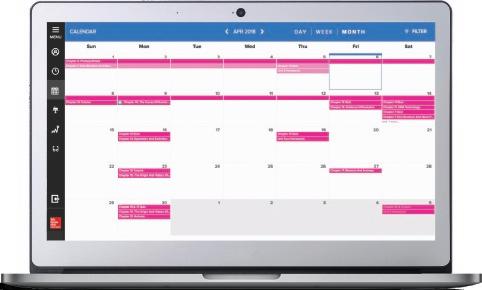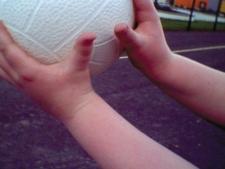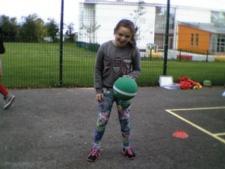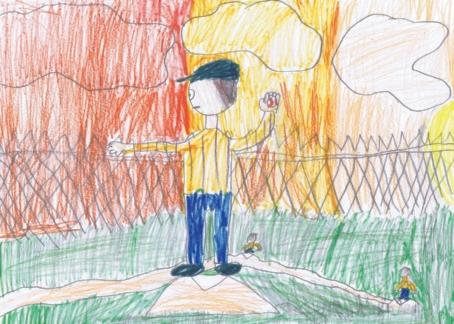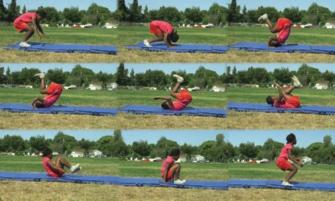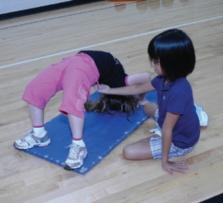Active Teaching Skills 93
CHAPTER
7
Establishing an Environment for Learning 95
Gymnasium Atmosphere 97
The Managerial Component 101 Developing Protocols 101 Establishing Rules and Expectations That Reflect a Positive Environment 101 Establishing Gymnasium Routines 104 Getting Off to a Good Start 108 School-Wide Programs 110
Teaching Skills for Establishing the Managerial Aspects of the Learning Environment 110 Teaching Protocols 110
The Instructional Component 112 Content Development 112
Communication 112
Congruent Feedback 113
Accommodating Individual Differences 114 Teaching by Invitation 114 Intratask Variation 114
Safety 115
Elements of Negligence 115
Areas in Which Negligence Might Occur 116
Summary 117
Reading Comprehension Questions 118
References/Suggested Readings 119
CHAPTER 8
Maintaining Appropriate Behavior 120
Preventing Misbehavior 121
Increasing Appropriate Behavior 123
Proactive Strategies 123
Reactive Approaches 125
Decreasing Inappropriate Behavior 126
Positive Practice 127
Desists 127
Working Independently Away from the Group 127
Time-outs 128
Conflict Resolution Strategies 128
Behavior Contracts 130
Communication to Parents 130
Involving the Principal 131
Maintaining Appropriate Behavior in Entire Classes 132
Reward Systems 134
Developing Personal and Social Responsibility 135
Corporal Punishment 135
Teaching Skills to Maintain a Productive Learning
Environment 135
Summary 136
Reading Comprehension Questions 137
References/Suggested Readings 137
CHAPTER 9
Instructional Approaches 139
Direct versus Indirect Instruction 140
Instructional Approaches 141
Interactive Teaching 141
Task Teaching 143
Peer Teaching 145
Guided Discovery 147
Convergent Inquiry 147
Divergent Inquiry 148
Cooperative Learning 149
Child-Designed Instruction 151
Choosing the “Right” Instructional Approach 153
Summary 154
Reading Comprehension Questions 155
References/Suggested Readings 155
CHAPTER
10
Adapting the Content for Diverse Learners 157
Inclusion as a Philosophy 158
Overweight Children 160
Cultural Differences 161
Gender Equity 162
Religious Differences 162
Children Living in Poverty 163
Children with Disabilities, Impairments, and Disorders 164
Individualized Education Program 165
Implementing the IEP 165
Physical Disabilities 166
Intellectual Disabilities 167
Emotional and Behavioral Disorders 169
Social Interaction Disorders 169
Visual Impairments 170
Hearing Impairments 170
Health-Related Disorders 171
Creating an Inclusive Environment 172
A Final Thought 173
Summary 173
Reading Comprehension Questions 174
References/Suggested Readings 174
CHAPTER
11
Reflecting on Student Responses 176
What to Observe 178
Safety 178
On-Task Behavior 179
Class Movement Patterns 179
Individual Movement Patterns 181
How to Observe 182
Positioning 182 Strategies 183
Summary 185
Reading Comprehension Questions 186
References/Suggested Readings 186
CHAPTER
12
Assessing Student Learning 187
Assessment for Learning 188
Understanding Assessment for Learning 189
Linking of Assessment and Instruction 190
Assessment Is Learner Centered 190
Assessment Is an Ongoing Process 190
Assessment Comprises Meaningful Tasks 191
Criteria for Assessment Are Known in Advance 191
Making It Work 191
What Has Been Learned? Selecting Assessment
Options 193
Informal Assessments 193
Formal Assessments 194
Teacher Observation 194
Exit (or Entrance) Slips 195
Student Journals 196
Homework 198
Peer Observation 199
Self-Assessment 201
Event Tasks 202
Digital Recordings 203
Technology and Assessment 204
Student Drawings 205
Student Displays 205
Portfolios 205
Assessing How Well Something Was Learned 206
Writing Rubrics 206
Assessing All Three Domains 208 Fitness Assessments 209
A Word about Assessing Movement Concepts 209
Assessment of Students with Disabilities 210
What to Do with the Results of Assessment, or StandardsBased Summarizing and Reporting Progress 213 Grading 213
Finding the Time for Assessment 218
Summary 220
Reading Comprehension Questions 220
References/Suggested Readings 221
CHAPTER 13
Reflecting on Teaching 222
Self-Reflection: Describing Your Teaching 224
Systematic Observation: Critiquing Your Teaching 224
Getting Started 224
Unassisted Techniques 224
Assisted Techniques 227
Making Sense of It All: Combining and Adapting Techniques and Setting Goals 234
Being Observed 235
Professional Learning Communities 235
Summary 236
Reading Comprehension Questions 236
References/Suggested Readings 236
PART FOUR
Movement Concepts Development 239
CHAPTER 14
Space Awareness 241
Developing the Concept of Location 244
Developing the Component of Self-Space 244
Teaching the Component of Self-Space 244
Learning Experiences Leading to Movement Concept Understanding 245
Exploring Self-Space 245
Curling, Stretching, and Twisting in Self-Space 245
Moving the Whole Body in Self-Space 246
Developing the Component of General Space 246
Teaching the Component of General Space 246
Learning Experiences Leading to Movement Concept
Understanding 246
Exploring General Space 246
Open Spaces 247
Reducing the Size of the General Space 247
Reducing the Size of General Space and Changing Speed 247
Dodging in General Space 247
Traveling Over, Under, and Around Obstacles in General Space 248
Space Awareness Obstacle Course 248
Developing the Concept of Directions 249
Teaching the Concept of Directions 249
Learning Experiences Leading to Movement Concept
Understanding 249
Traveling in Different Directions 249
Moving Clockwise and Counterclockwise 249
Exploring Directions 250
Changing Directions on Signal 250
Turning While Moving in Different Directions 250
Developing the Concept of Levels 250
Teaching the Concept of Levels 251
Learning Experiences Leading to Movement Concept
Understanding 251
Traveling and Freezing at Different Levels 251
Traveling with Body Parts at Different Levels 251
Rising and Sinking to Create Different Levels 251
Traveling While Rising and Sinking 251
Developing the Concept of Pathways 252
Teaching the Concept of Pathways 252
Learning Experiences Leading to Movement Concept
Understanding 252
Exploring Pathways 252
Using Pathway Maps 252
Designing Pathways 253
Creating Follow-the-Leader Pathways 253
Traveling Pathways and Obstacles 253
Following-the-Dots Pathways 254
Combining Pathways, Levels, and Directions 255
Developing the Concept of Extensions in Space 256
Teaching the Concept of Extensions in Space 256
Learning Experiences Leading to Movement Concept
Understanding 256
Exploring Extensions 256
Traveling and Extensions 256
Changing from One Extension to Another 256
Using Extensions and Imagery 256
Applying the Space Awareness Concepts 257
Reading Comprehension Questions 257
References/Suggested Readings 258
CHAPTER 15
Effort 259
Developing the Concept of Time 261
Teaching the Concept of Time 262
Learning Experiences Leading to Movement Concept
Understanding 262
Exploring Time 262
Using Different Speeds in Self-Space 262
Moving at Different Speeds 263
Traveling and Freezing by Using Changes in Time 264
Combining Imagery and Time 265
Differentiating Among Time Words 265
Combining Sport Skills and Time 265
Continually Changing in Time While Traveling 265
Developing the Concept of Force 267
Teaching the Concept of Force 268
Learning Experiences Leading to Movement Concept
Understanding 268
Exploring Force 268
Traveling and Changing Force Qualities 268
Using Imagery and Force 268
Showing Contrasts of Force 268
Developing the Concept of Flow 269
Teaching the Concept of Flow 269
Learning Experiences Leading to Movement Concept
Understanding 269
Traveling and Flow 269
Eliciting Flow Qualities 270
Following Flow Sentences 270
Practicing Flow Sequences 271
Using Flow for Movement Conversations 271
Combining Time, Force, and Flow 271
Applying the Effort Concepts 272
Reading Comprehension Questions 273
References/Suggested Readings 273
CHAPTER 16
Relationships 274
Developing the Concept of the Relationships of Body Parts 275
Teaching the Concept of the Relationships of Body Parts 277
Learning Experiences Leading to Movement Concept
Understanding 277
Identifying Body Parts 277
Freezing on Different Body Parts 278
Traveling on Different Body Parts 278
Balancing on Matching and Nonmatching Parts 278
Round, Narrow, Wide, and Twisted Body Shapes 278
Changing from One Body Shape to Another 279
Traveling and Freezing in Different Body Shapes 280
Making Symmetrical and Nonsymmetrical Shapes 280
Creating Postcard Sculptures 281
Creating Body Shapes in the Air 281
Developing the Concept of the Relationships with Objects 283
Teaching the Concept of the Relationships with Objects 283
Learning Experiences Leading to Movement Concept
Understanding 283
Traveling Over, Close to, Far Away, Inside 283
Traveling Over, Under, Close to, and Far Away from Equipment 284
Onto/Off Concepts 284
Over, Under, Around, In Front Of, and Behind Concepts 285
Traveling on Equipment 285
Traveling Through Obstacles 286
Going Over and Under the Obstacle Course 287
Developing the Concept of the Relationships with People 287
Alone in a Mass 287
Solo 287
Partners 287
Groups 288
Between Groups 288
Teaching the Concept of the Relationships with People 288
Learning Experiences Leading to Movement Concept
Understanding 288
Matching 288
Leading and Following 289
Traveling and Matching 289
Mirroring 289
Matching and Mirroring 290
Traveling Alongside/Following 290
Following with a Group 290
Meeting/Parting 291
Forming Cooperative and Collaborative Relationships 291
Meeting and Parting in a Cooperative Group 292
Performing Solo 292
Applying the Concept of Relationships 292
Competition 293
Reading Comprehension Questions 293
References/Suggested Readings 294
PART FIVE
Skill Theme Development 295
CHAPTER 17 Traveling 297
Fundamental Locomotor Skills 298
Walking 299
Hopping 299
Skipping 299
Galloping 300
Sliding 300
Running 300
Leaping 301
Precontrol Level (GLSP): Experiences for Exploration 303
Traveling in General Space 303
Traveling with Different Locomotor Movements 304
Traveling in Different Ways 304
Traveling with Imagery 304
Traveling Through Rope Pathways 304
Traveling Among Wide and Narrow Shapes 305
Control Level (GLSP): Learning Experiences Leading to Skill Development 305
Traveling with Different Locomotor Patterns 305
Hopping 306
Skipping 306
Galloping 306
Sliding 306
Running 307
Leaping 307
Traveling to Open Spaces 308
Performing Locomotor Sequences 308
Moving to Rhythms 309
Traveling with Music 309
Traveling an Obstacle Course 309
Traveling in Different Directions 310
Skip and Balance Dance 310
Traveling in Different Pathways 311
Locomotors and Rhythm: The Follow-Me Dance 311
The Locomotors, Directions, and Pathways Dance 312
Traveling Using Different Directions, Levels, Pathways, and Locations 312
Changing Speeds to Music 313
Traveling with Changes in Speed: A Dance of Water, Steam, and Ice 313
Traveling in Slow-Motion: The Sports Dance 314
Combination Locomotors 314
Utilization Level (GLSP): Learning Experiences Leading to Skill Development 314
Traveling with a Partner: Matching Pathways 314
Traveling with a Partner: Copying Locomotors and Directions 316
Traveling with a Partner: Changing Speed and Direction 316
Shadowing a Partner’s Travel 316
Meeting and Parting While Traveling with a Partner 316
Performing Rhythmical Patterns 317
Traveling to Tell a Story: The Fountain of Youth Dance 317
Traveling in Bound and Free Flow 317
Proficiency Level (GLSP): Learning Experiences Leading to Skill Development 318
Traveling with Shapes and Actions: A Story Without Words 318
Body Shapes and Group Travel: A Study in Form 318
Performing Rhythmical Patterns: Jump Bands/Aerobic
Tinikling 319
Traveling in Games and Sports 321
Traveling in Gymnastics 321
Reading Comprehension Questions 322
References/Suggested Readings 322
CHAPTER 18
Chasing, Fleeing, and Dodging 323
Chasing 325
Fleeing 325
Dodging 325
Levels of Skill Proficiency 325
Precontrol Level (GLSP): Experiences for Exploration 326
Moving Obstacles 326
Traveling to Flee 327
Traveling to Dodge 327
Make-Believe Chase 327
Control Level (GLSP): Learning Experiences Leading to Skill Development 327
Dodging in Response to a Signal 328
Dodging and Tagging in a Small Space 328
Fleeing from a Partner 328
Dodging the Obstacles 329
Dodging with Quick Changes of Speed: Darting 329
Overtaking a Fleeing Person 329
Fleeing a Chaser 329
Utilization Level (GLSP): Learning Experiences Leading to Skill Development 330
Dodging Stationary Obstacles 330
Dodging and Faking Moves to Avoid a Chaser 331
Dodging Limited Movement Obstacles 331
Dodging and Chasing One Person in a Mass 332
Dodging in a Dynamic Situation 333
Dodging While Manipulating an Object 333
Proficiency Level (GLSP): Learning Experiences Leading to Skill Development 333
Child-Designed Dance 334
Continual Fleeing and Chasing with a Large Group 334
Dodging While Maintaining Possession of an Object 334
Chasing and Dodging Simultaneously 335
Chasing and Fleeing in an Invasion Gamelike Situation 335
Dodging in a Gamelike Situation 336
Dodging in a Target Gamelike Situation 337
Using Team Strategy for Chasing, Fleeing, and Dodging in an Invasion Gamelike Situation 337
Dodging While Manipulating an Object in an Invasion Gamelike Situation 338
Self-Designed Chasing, Fleeing, and Dodging Game 338
Reading Comprehension Questions 339
References/Suggested Readings 339
CHAPTER 19
Bending, Stretching, Curling, and Twisting 340
Precontrol Level (GLSP): Experiences for Exploration 341
Stretching in Self-Space 341
Curling in Self-Space 342
Curling to Roll Like a Ball 342
Bending Body Parts 342
Twisting in Self-Space 343
Stretching, Body Shapes, and Locomotion 343
Stretching and Curling 343
Control Level (GLSP): Learning Experiences Leading to Skill Development 344
Balancing with Bends, Stretches, Twists, and Curls 344
Bending, Stretching, Twisting, and Curling in Mime 345
Jumping Off While Stretching and Twisting 345
Jumping Over While Stretching, Bending and Twisting 345
A Dance of Stretching, Bending, Twisting, and Curling 346
Performing Jumping Sequences with Bending, Twisting, Curling, and Stretching 346
Catching with a Stretch and Curl 347
Stretching to Catch a Ball with a Partner 347
Stretching for the Jump Ball 348
Twisting to Catch a Ball with a Partner 348
Twisting While Striking with a Bat 348
Twisting While Striking a Tossed Ball 348
Twisting for Placement When Batting 349
Stretching, Curling, and Twisting into Weight Transfers 349
Balancing on Apparatus with Body Actions 350
Utilization Level (GLSP): Learning Experiences Leading to Skill Development 350
Transferring Weight to Hands and Twisting 350
Transferring Weight to Hands and Forming a Bridge 351
Stretching to Catch with a Partner While Traveling 351
Stretch, Catch, Release 351
Stretching to Catch Against an Opponent 351
Stretching, Curling, Bending, and Twisting Against an Opponent 352
Stretching, Curling, Bending, and Twisting Against Multiple Opponents 352
Proficiency Level (GLSP): Learning Experiences Leading to Skill Development 352
Reading Comprehension Questions 353
Reference/Suggested Reading 353
CHAPTER 20
Jumping and Landing 354
Fundamental Jumping Patterns 355
Precontrol Level (GLSP): Experiences for Exploration 357
Jumping and Landing: Exploring Different Patterns 357
Jumping Far 359
Jumping High 359
Jumping over a Swinging Rope 359
Control Level (GLSP): Learning Experiences Leading to Skill Development 359
Jumping and Landing: Basic Patterns 360
Jumping for Distance 361
Jumping for Height 361
Jumping over Low Obstacles: Hoops 362
Jumping over Low Obstacles: Hurdles 362
Jumping Rhythmically 363
Jumping in Rhythmical Sequences 363
Jumping a Turned Rope 363
Jumping a Self-Turned Rope 364
Jumping Using Buoyant and Yielding Landings 364
Jumping to Form a Body Shape During Flight 365
Traveling, Jumping, and Body Shapes 366
Performing Jumping Sequences and Making Body Shapes 366
Jumping over Equipment Using Buoyant Landings 367
Jumping On and Off Equipment Using Buoyant and Yielding Landings 367
Jump, Squash, TaDa 367
Jumping and Landing Task Sheet 368
Utilization Level (GLSP): Learning Experiences Leading to Skill Development 368
Jumping to Catch 368
Jumping to Throw 370
Jumping on a Bench 370
Throwing and Catching While Jumping 370
Jumping to an Accented Beat 371
Proficiency Level (GLSP): Learning Experiences Leading to Skill Development 372
Jumping with a Partner to Mirror Actions 372
Jumping with a Partner to Match Actions 372
Jumping with a Springboard 373
Jumping as Part of a Dance Creation 373
Jumping, Dancing, and Imagery 373
Jumping Hurdles 374
Reading Comprehension Questions 374
References/Suggested Readings 374
CHAPTER 21
Balancing
375
Precontrol Level (GLSP): Experiences for Exploration 377
Balancing on Different Bases of Support 377
Balancing on a Wide Base of Support 378
Balancing in Different Body Shapes 378
Traveling and Stopping in Balanced Positions 378
Traveling on Low Gymnastics Equipment 379
Balancing on Boards 379
Control Level (GLSP): Learning Experiences Leading to Skill Development 379
Balancing on Different Bases of Support 380
Tightening the Gymnastics Muscles 380
Counterbalance 380
Balancing Symmetrically and Nonsymmetrically 381
Balancing in Different Body Shapes 381
Balances and Shapes: The Gymnastics Dance 384
Performing Inverted Balances 384
Alignment of Body Parts 385
Doing Kickups 385
Traveling and Stopping in Balanced Positions 386
Stationary Balances on Equipment 386
Traveling on Large Apparatus 388
Traveling While Balanced 389
Balancing Sequence 389
Balancing on Stilts 390
Balance Boards 391
Utilization Level (GLSP): Learning Experiences Leading to Skill Development 392
Balancing on Crates 393
Moving out of and into Balances by Stretching, Curling, and Twisting 393
Traveling into and out of Balances by Rolling 394
Performing Inverted Balances on Equipment 395
Performing Sequences That Combine Stationary Balances and Traveling on Mats 395
Proficiency Level (GLSP): Learning Experiences Leading to Skill Development 396
Balancing While Supporting the Weight of a Partner 397
Balancing on Hanging Ropes 397
Transferring Off Equipment with Weight on Hands 398
Performing Apparatus Sequences That Combine Stationary Balances and Traveling with Movement Concepts 398
Reading Comprehension Questions 399
References/Suggested Readings 400
CHAPTER 22
Transferring Weight and Rolling 401
Transferring Weight 402
Precontrol Level (GLSP): Experiences for Exploration 403
Locomotor Actions 403
Transferring Weight with a Rocking Action 403
Transferring Weight to Hands Momentarily 404
Transferring Weight onto and off Equipment 404
Control Level (GLSP): Learning Experiences Leading to Skill Development 404
Transferring Weight from Feet to Hands to Feet 404
Transferring Weight from Feet to Back with a Rocking Action 404
Transfers with Stretching, Curling, and Twisting 405
Performing Spring/Step Takeoffs 406
Performing Spring/Step Takeoffs onto Crates and/or Benches 406
Transferring off Low Apparatus (Benches, Crates, or Low Tables) 406
Making Spring/Step Takeoffs with Sequences 407
Traveling over Low Apparatus 407
Transferring onto Low Apparatus 408
Maintaining Transfer from Feet to Hands 408
Transferring Weight to Hands by Stepping: Cartwheels 409
Utilization Level (GLSP): Learning Experiences Leading to Skill Development 409
Transferring Weight to Hands: Walking 410
Transferring Weight to Hands and Twisting 410
Transferring Weight to Hands and Forming a Bridge 410
Transferring Weight onto Large Apparatus 411
Transferring Weight to Head and Hands on Apparatus (Box, Beam, Table) 412
Transferring Weight onto Bars (Parallel Bars, Climbing Frame) 412
Transferring Weight over Apparatus (Vaulting Box) 412
Transferring Weight Along Apparatus 414
Transferring Weight to Hands on Low Apparatus 414
Transferring Weight on Bars 414
Combining Skills on Mats 414
Combining Weight Transfer and Balances into Sequences on Mats and Apparatus 415
Proficiency Level (GLSP): Learning Experiences Leading to Skill Development 416
Rolling 416
Precontrol Level (GLSP): Experiences for Exploration 417
Making Curled Shapes 418
Rocking on Different Body Parts 418
Rolling Sideways 419
Curling to Roll 419
Control Level (GLSP): Learning Experiences Leading to Skill Development 419
Rocking to Match a Partner 419
Rolling in a Long, Narrow Position (Log Roll) 419
Rolling Sideways on Different Body Parts 420
Forward Shoulder Roll 420
Rocking Backward 421
Forward Straddle Roll 421
Rolling Over 421
Rolling Forward 422
Rocking Backward over the Shoulders 423
Rolling from Different Positions 424
Rolling at Different Speeds 424
Back Shoulder Roll 425
Rolling in Different Directions 425
Rolling from Different Directions and Positions 426
Linking Rolls 427
Rolling Using Different Directions and Speeds 427
Rolling After Jumping Off Equipment and Landing 428
Rolling After Jumping for Height and Landing 428
Rolling After Jumping from Different Heights 429
Rolling After Jumping over Equipment and Landing 429
Rolling, Levels, Directions, and Jumping 430
Rolling While Traveling, Jumping, and Landing 430
Utilization Level (GLSP): Learning Experiences Leading to Skill Development 431
Rolling and Traveling Quickly 432
Rolling, Jumping, and Traveling in Relationship to Others 432
Rolling over Low Hurdles 432
Rolling on Low Equipment 433
Rolling off Low Equipment 433
Traveling and Rolling Between Pieces of Equipment 434
Rolling, Balancing, and Rolling 434
Rolling to Express an Idea 434
Rolling While Throwing and Catching 435
Rolling onto Low Equipment 435
Rolling and Balancing on Equipment 435
Rolling to Meet and Part 436
Rolling and Striking 436
Catching, Throwing, and Rolling 436
Proficiency Level: Learning Experiences Leading to Skill Development 437
Reading Comprehension Questions 437
References/Suggested Readings 437
CHAPTER 23
Kicking and Punting 438
Kicking 440
Precontrol Level (GLSP): Experiences for Exploration 441
Kicking a Stationary Ball from a Stationary Position 441
Approaching a Stationary Ball and Kicking 441
Tap/Dribble the Ball 441
Control Level (GLSP): Learning Experiences Leading to Skill Development 442
Kicking on the Ground 442
Kicking in the Air 442
Kicking for Distance Along the Ground and in the Air 443
Kicking to a Distance Zone 444
Kicking a Rolling Ball from a Stationary Position 444
Kicking a Rolling Ball from a Running Approach 445
Kicking at Low Targets 445
Kicking to Targets 445
Kicking/Passing to a Partner 447
Dribbling the Ball along the Ground 447
Dribble: Starting and Stopping 448
Dribble: Traveling in Pathways 449
Dribbling Around Stationary Obstacles 449
Dribble: Control of Ball and Body 449
Utilization Level (GLSP): Learning Experiences Leading to Skill Development 450
Changing Directions: Dribble 450
Performing a Continuous Dribble and Change of Direction 450
Traveling and Kicking for a Goal 451
Playing One-on-One Soccer 451
Dribble and Kick: Playing Soccer Golf 452
Kicking to a Partner from Various Angles 453
Kicking to a Traveling Partner 453
Passing to a Partner in General Space 454
Playing Two-on-One Soccer 454
Proficiency Level (GLSP): Learning Experiences Leading to Skill Development 454
Kicking at Small Stationary Targets 455
Kicking at a Moving Target 455
Playing Mini Soccer 455
Playing Soccer Keep-Away 456
Playing Alley Soccer 456
Playing Cone Soccer 456
Punting 457
Precontrol Level (GLSP): Experiences for Exploration 458
Dropping, Bouncing, and Kicking Lightweight Balls 458
Dropping and Punting 459
Control Level (GLSP): Learning Experiences Leading to Skill Development 459
Punting for Consistency 459
Punting over Low Ropes 460
Punting with an Approach 460
Punting Different Types of Balls 460
Punting for Distance 461
Using Punting Zones 461
Punting for Accuracy 462
Punting for Height 462
Utilization Level (GLSP): Learning Experiences Leading to Skill Development 463
Punting at Angles 463
Punting to a Partner 463
Receiving a Pass, Then Punting 463
Punting Within a Limited Time 464
Punting Quickly: Rush the Circle 465
Proficiency Level (GLSP): Learning Experiences Leading to Skill Development 465
Receiving and Punting Against Opponents 465
Punting While Traveling 466
Punting for Distance and Accuracy: Punt Over 466
Reading Comprehension Questions 467
References/Suggested Readings 467
CHAPTER 24
Throwing and Catching 468
Throwing 470
Catching 472
Precontrol Level (GLSP): Experiences for Exploration 473
Throwing a Yarn Ball Against the Wall 473
Throwing at a Large Target 474
Catching a Rolling Ball 474
Catching from a Skilled Thrower 474
Drop–Catch 475
Tossing to Self and Catching 475
Control Level (GLSP): Learning Experiences Leading to Skill Development 475
Throwing Underhand 476
Throwing Overhand 476
Throwing Sidearm 476
All Three Throwing Patterns: Over, Under, and Side 477
Bouncing a Ball to Self and Catching It 477
Throwing an Object to Different Levels and Catching It 478
Catching in Different Places Around the Body 478
Throwing Underhand for Distance (Varying the Force) 479
Overhand Throwing for Distance 480
Throwing Overhand at a High Stationary Target 480
Throwing Overhand at a Low Stationary Target 480
Throwing Underhand to Low Targets 481
Throwing Underhand to Targets: Hoops 481
Throwing to High Targets 482
Throwing Backhand to a Target 482
Throwing and Catching a Flying Disc 482
Catching with a Scoop 483
Catching off the Fly 483
Throwing a Ball Against a Wall and Catching the Rebound 484
Throwing and Catching with a Partner 484
Throwing and Catching over a Net with a Partner 485
Catching off a Bounce 485
Utilization Level: Learning Experiences Leading to Skill Development 486
Catching at Different Levels 487
Moving to Catch 487
Throwing and Catching While Traveling 488
Throwing and Catching Different Objects 488
Throwing on the Move 489
Throwing to Make a Partner Move to Catch 490
Throwing to a Moving Target 491
Throwing for Distance and Accuracy 491
Throwing at a Target from Different Distances 492
Throwing Flying Discs at Targets 493
Catching to Throw Quickly to a Partner 493
Catching to Throw Quickly to a Target 494
Throwing While in the Air 494
Proficiency Level: Learning Experiences Leading to Skill Development 494
Throwing and Catching a Flying Disc in Different Places Around the Body with a Partner 495
Throwing and Catching in a Field, Run, and Score Game-like Situation 495
Throwing to Avoid a Defender 496
Throwing and Catching in a Small-Sided Invasion Game 496
Throwing at a Stationary Object While Being Defended 497
Throwing and Catching in a Small-Sided Keep-Away Type Invasion Game 497
Throwing and Catching with a Flying Disc in a Small-Sided Invasion Game 498
Throwing and Catching with a Football in a Small-Sided Invasion Game 498
Throwing, Catching, and Dribbling in a Small-Sided Invasion Game 499
Throwing and Catching While Using Simple Offense and Defense in a Small-Sided Invasion Game 500
Reading Comprehension Questions 500
References/Suggested Readings 501
CHAPTER 25
Volleying and Dribbling 502
Volleying 503
Precontrol Level (GLSP): Experiences for Exploration 504
Volleying Balloons in the Air 504
Volleying a Balloon Forward 504
Volleying with Different Body Parts 505
Volleying Lightweight Objects 505
Control Level (GLSP): Learning Experiences Leading to Skill Development 506
Volleying a Ball Noncontinuously with Different Body Parts 506
Volleying a Ball Upward (Underhand Pattern) 506
Volleying a Ball Upward with the Forearms 507
Volleying a Ball to the Wall (Underhand Pattern) 507
Volleying to a Partner (Underhand Pattern) 508
Volleying for Force and Angle (Underhand Pattern) 508
Volleying for Direction and Accuracy: Four Square, Two Square 509
Volleying over a Low Net (Underhand Pattern) 509
Volleying to the Wall (Overhead Pattern) 510
Volleying a Ball Upward (Overhead Pattern) 510
Volleying to a Partner (Overhead Pattern) 511
Cooperative Volleys (Overhead Pattern) 511
Volleying with a Bounce 511
Obstacle-Course Volley 511
Utilization Level (GLSP): Learning Experiences Leading to Skill Development 512
Volleying Game: Child-Designed 513
Volleying a Ball Continuously with Different Body Parts 513
Volleying with the Foot 513
Volleying from Head to Foot: Aerial Soccer 514
Volleying with a Volleybird 515
Striking to the Wall—Varying Levels, Force, and Body Position 515
Volleying over a High Net (Overhead Pattern) 516
Volleying Continuously to a Partner 516
Volleying Three-on-Three 517
Volleying over a High Net (Underhand Pattern) 517
Proficiency Level (GLSP): Learning Experiences Leading to Skill Development 518
Volleying with Different Body Parts While Traveling 518
Striking Downward with Force 518
Volleying in a Line Formation 518
Volleying Game: Modified Teacher-Designed Game 519
Dribbling 519
Precontrol Level (GLSP): Experiences for the Exploration 520
Bouncing a Ball Down and Catching It 520
Bouncing a Ball Down (Dribbling) Continuously 521
Dribbling and Walking 521
Control Level (GLSP): Learning Experiences Leading to Skill Development 521
Dribbling in Self-Space 522
Continuous Dribbling 522
Dribbling at Different Levels 522
Dribbling and Looking 523
Dribbling While Switching Hands 524
Dribbling with the Body in Different Positions 524
Dribbling in Different Places Around the Body While Stationary 524
Dribble While Changing Directions in Self-Space 525
Dribbling and Traveling 526
Dribbling, Traveling, and Switching Hands 526
Utilization Level (GLSP): Learning Experiences Leading to Skill Development 526
Dribbling and Changing Speed of Travel 527
Dribbling in General Space While Changing Directions 527
Dribbling in Different Pathways 527
Mirroring and Matching While Dribbling 529
Dribbling While Stopping, Starting, and Turning (Pivots and Fakes) 529
Dribbling Around Stationary Obstacles in General Space 530
Dribbling Around Stationary Obstacles in Limited Space 530
Dribbling and Passing with a Partner 530
Dribbling Against an Opponent: One-on-One 531
Proficiency Level (GLSP): Learning Experiences Leading to Skill Development 532
Dribbling Against Opponents: Stationary Defenders 532
Dribble Tag 532
Dribbling While Dodging 533
Maintaining Possession While Dribbling and Passing 533
Child-Designed Dribbling/Passing Routines 533
Dribbling and Throwing at a Target 534
Dribble/Pass Keep-Away 534
Child-Designed Invasion Game 534
Reading Comprehension Questions 535
References/Suggested Readings 535
CHAPTER 26
Striking with Rackets and Paddles 536
Precontrol Level (GLSP): Experiences for Exploration 538
Paddle Balance 539
Balloon Strike (Lightweight Paddle) 540
Striking a Suspended Ball 540
Hit the Wall 541
Upward Bound 541
Control Level (GLSP): Learning Experiences Leading to Skill Development 542
Striking Down 542
Striking Up 543
Striking Up and Down 543
Striking Underhand Against a Wall 544
Striking Up, Down, and Underhand Forward 545
Striking to Self on Both Sides of the Body 545
Striking Underhand to Wall Targets 546
Striking Underhand for Distance (Varying the Force) 546
Striking Underhand to Hoops (Varying the Distance) 546
Striking Forehand to the Wall 547
Striking at High and Low Targets 547
Striking to Different Places 549
Striking Through a Target 549
Striking an Object to Send It over a Net 550
Striking Backhand to the Wall 551
Striking Continuously Over and Through a Target 551
Striking a Ball Rebounding from a Wall 552
Utilization Level (GLSP): Learning Experiences Leading to Skill Development 553
Hitting from Different Places 553
Hitting Cooperatively and Continuously with a Partner 553
Striking to Different Places Around a Partner 554
Striking Overhead 554
Striking Overhead over a Net 554
Striking Continuously Upward with a Group 555
Striking in Various Aerial Pathways in Dynamic Situations 555
Striking Upward in a Dynamic Situation 556
Proficiency Level (GLSP): Learning Experiences Leading to Skill Development 557
Striking to One Wall with a Partner 557
Striking at Angles to Two Walls with a Partner 557
Striking to and from Different Places 558
Partner Striking Across a Net 558
Aerial Striking over a Net 559
Team Striking Across a Net 559
Group Striking Across a Net 560
Child-Designed Racket Games 560
Reading Comprehension Questions 560
References/Suggested Readings 561
CHAPTER 27
Striking with Long-Handled Implements 562
Striking with Long-Handled Implements—Hockey Sticks 564
Precontrol Level (GLSP): Experiences for Exploration 565
Striking a Stationary Ball 565
Striking (Dribbling) a Ball in Self-Space 565
Traveling Slowly While Striking a Ball 565
Control Level (GLSP): Learning Experiences Leading to Skill Development 566
Striking a Stationary Ball on the Ground 566
Striking to Targets 567
Striking Toward a Target (Around the World) 567
Striking to a Stationary Partner 568
Traveling Slowly While Striking a Ball 568
Traveling, Stopping, and Controlling the Ball 569
Traveling and Changing Speeds 569
Traveling and Striking While Changing Pathways 570
Striking While Dodging Stationary Obstacles 570
Utilization Level (GLSP): Learning Experiences Leading to Skill Development 571
Striking to Small Targets 571
Performing a Continuous Dribble with Changes in Direction and Speed 571
Pathways, Speeds, and Directions 572
Traveling and Striking for a Goal 573
One-on-One Hockey 573
Striking from a Stationary Position to a Moving Target 573
Passing and Receiving on the Move 574
Keeping It Moving 574
Two-on-One Hockey 574
Proficiency Level (GLSP): Learning Experiences Leading to Skill Development 575
Striking to Dodge an Opponent 575
Keep-Away 576
Small-Sided Hockey Invasion Game 576
Striking with Long-Handled Implements—Bats 577
Precontrol Level (GLSP): Experiences for Exploration 578
Striking Off a Batting Tee 578
Control Level (GLSP): Learning Experiences Leading to Skill Development 578
Striking a Stationary Ball 579
Level Swings 580
Striking a Stationary Ball for Distance 581
Striking Suspended Objects 581
Hit and Run 582
Striking a Self-Tossed Ball 582
Striking a Self-Tossed Ball to Different Distances 583
Striking a Self-Tossed Ball for Accuracy 583
Striking a Pitched Ball 584
Utilization Level (GLSP): Learning Experiences Leading to Skill Development 585
Grounders and Flies 585
Directing the Placement of an Object 585
Striking a Pitched Ball Varying the Distance 586
Hitting a Pitched Ball to Open Spaces 586
Batting, Combining Distance and Placement 587
Proficiency Level (GLPS): Learning Experiences Leading to Skill Development 587
Directing the Pathway, Distance, and Speed of an Object 587
Six-Player Striking and Fielding in a Game-like Situation 588
One-Base Baseball 588
Striking with Long-Handled Implements—Golf Clubs 589
Precontrol Level (GLSP): Experiences for Exploration 589
Putting 589
First Swings 590
Control Level (GLSP): Learning Experiences Leading to Skill Development 590
Striking a Ball so It Travels in the Air: Air Ball 590
Striking to Varying Distances 591
Putting for Accuracy 591
Striking for Accuracy 591
Utilization Level (GLSP): Learning Experiences Leading to Skill Development 592
Playing Hoop Golf 592
Whiffle Ball Golf 592
Box Golf 593
Proficiency Level (GLSP): Learning Experiences Leading to Skill Development 593
Reading Comprehension Questions 594
References/Suggested Readings 594
PART SIX
Skill Theme Application 595
CHAPTER 28
Teaching Physical Fitness, Physical Activity, and Wellness 597
Fitness: Past and Present 599
Health-Related Fitness for Children 599
FITT for Children 600
Fitness in the Physical Education Curriculum 600
Focus Lessons 602
Assessing Health-Related Fitness 602
After the Assessment 605
Final Thoughts on Fitness 607
Importance of Physical Activity 607
Physical Inactivity 608
Guidelines for Physical Activity 608
Comprehensive School Physical Activity Program (CSPAP) 609
Goals of CSPAP 610
CSPAP in Elementary Schools 610
Breaks in the Classroom and Movement Opportunities to Teach Academic Content 611
Community Programs and Events 611
Working with Parents 612
CSPAP: Who Is Responsible? 612
Getting Started with CSPAP 612
Wellness for Children 613
School Wellness Programs 614
Mental and Emotional Health 614
Personal and Social Responsibility 615
Nutrition 615
MyPlate 616
The Good Health Balance 616
A Final Note on Wellness 617
Summary 617
Reading Comprehension Questions 618
References/Suggested Readings 618
Appendix 28A: Family Fitness Activities 621
Appendix 28B: Prescriptions for Fitness 622
CHAPTER
29
Teaching Educational Dance 624
The Purpose of Dance in Elementary School 626
The Content of Dance 626
Predesigned Dance Experiences 627
Child-Designed Dance Experiences 629
The Teaching of Predesigned and Child-Designed Dance 632
Teaching Predesigned Rhythms 632
Teaching Predesigned Cultural Dance 632
Teaching Child-Designed Rhythms 633
Teaching Creative Dance 634
Use Books or Stories 636
Use Imagery 636
Begin Gradually 637
Start with a Cooperative Class 637
Start with Exciting Movement Experiences 637
Dance to the Music 637
Hesitant Learners 637
Final Thoughts 638
Dance and Fitness 638
Dance and the Affective Domain 638
Summary 638
Reading Comprehension Questions 638
References/Suggested Readings 639
Appendix 29A: Rhythmic Routines 640
Appendix 29B: Children Designing Their Own Dance: A Description of a Process 643
Appendix 29C: 645
CHAPTER
30
Teaching Educational Gymnastics 649
The Nature of Gymnastics 650
Gymnastics in Elementary School 650
Creating a Safe Learning Environment 652
Expectations of Safe Practice 652
Gymnastics Equipment 652
Selection of Tasks 653
The Content of Educational Gymnastics 654
Floor Experiences 654
Apparatus Experiences 655
Creating Sequences 656
Outdoor Play Equipment as Gymnastics Apparatus 657
The Teaching of Educational Gymnastics 657
Demonstrating 659
Stations 659
Club Gymnastics 660
A Final Thought 661
Summary 661
Reading Comprehension Questions 661
References/Suggested Readings 662
CHAPTER 31
Teaching Educational Games 663
The Nature of Games 664
The Purpose of Games in the Elementary School 665
Content of Games 665
Invariant Game Skill Development Experiences 667
Dynamic Game-like Experiences 668
Skills in a Changing Environment 669
Combinations of Skills 669
Tactics 670
Games-Playing Experiences 670
Predesigned Games-Playing Experiences 671
Child-Designed Games 672
The Teaching of Invariant Games Skill Development, Dynamic Game-like Skill Development, and GamesPlaying Experiences 674
Teaching Invariant and Dynamic Game-like Skill Development Experiences 674
Teaching Games-Playing Experiences 675
Considerations for Planning 675
Considerations While Teaching 676
After-School Sport Programs 678
Child Development and Games 678
A Final Thought 679
Summary 680
Reading Comprehension Questions 680
References/Suggested Readings 681
CHAPTER
32
Integrating the Skill Theme Approach Across the Curriculum 682
Connecting Physical Education and the Classroom Curriculum Through Interdisciplinary Learning 683
Defining Interdisciplinary Learning 683
Benefits of Interdisciplinary Education 683
Integrating Physical Education and Other Curricula Content 684
Benefits of Integration 684
Important Considerations 685
The Process of Teaching Using an Interdisciplinary Learning Approach 686
Content Linkage Approach 686
Shared Integration Approach 686
Developing an Integrated Learning Experience 686
Thematic Unit Approach 687
Understanding the Scope and Sequence of Subject Area
Content 691
The Connection Between Physical Activity and Academic Performance 692
What the Research Suggests: Physical Activity, Fitness, and Physical Education 692
What the Research Suggests: Brain-Based Learning 693
A Final Thought 694
Summary 694
Reading Comprehension Questions 694
References/Suggested Readings 695
PART SEVEN
The Future 697
CHAPTER 33
Building Support for Your Program 699
The Principal 700
Teachers in the School 702
Parents 703
The School Board 706
The Community at Large 707 Legislators 707
Children as Advocates 708
Summary 709
Reading Comprehension Questions 709
References/Suggested Readings 709
CHAPTER 34
Physical Education for Tomorrow’s Children 711
Index I-1
Children! Impressionable, innocent, enthusiastic, eager to learn, and all different. In fact, if you believe that all children are identical—same interests, same abilities, same size—then Children Moving is not the book for you. The authors of Children Moving recognize that each child is unique and different. One size does not fit all! The purpose of Children Moving is to guide you in the process of learning to teach a curriculum that is differentiated for a range of skill abilities and fitness levels. If all children were the same, we would be able to “package” a curriculum—the same games, gymnastic stunts, and dances you would do with all of the children as if they were identical. Children Moving will introduce you to a process of teaching—the reflective approach—that will provide the background for you to adapt, adjust, and modify lessons so they are interesting and worthwhile for all of the children you teach—from the lowest to the highest skill and fitness levels. The ultimate goal, of course, is to guide youngsters in the process of becoming physically active for a lifetime.
The importance of physical activity for one’s health is recognized today as never before. As we write this 10th edition, virtually no one questions the value of participating in 60 minutes, or more, of physical activity each day. Children Moving focuses on building the competence and confidence in children that lead to a lifetime of physical activity. It’s easy to recommend that children, and adults, become and remain physically active. As you may know, it’s much harder to do it.
Children Moving is not simply a description of games and activities for kids. Instead it emphasizes the importance of children actually learning to move by focusing on skill themes that are used in virtually all sports and physical activities. This text contains rich progressions of field-tested learning experiences that have the potential to assist children in becoming good movers. Competent movers typically enjoy physical activity and are eager participants. In contrast, incompetent movers who are poorly skilled are far more likely to avoid physical activity. Each logical, developmentally appropriate skill theme progression is described with word-for-word examples of what teachers actually say to the children during the lessons. This is especially valuable for novice teachers and those with little experience teaching by skill themes. In addition to providing detailed tasks that can be used to develop safe and child-centered lessons for the skill themes, Children Moving also devotes 10 chapters to
the process of teaching (Parts 2 and 3). These pedagogical skills are based in the research literature and also years and years of teaching experience. If you want to become a good teacher, you understand effective teachers do a lot more than just keep kids “busy, happy, and good.” They develop logical skill progressions that are the foundation of sports skills and physical activities and then they provide copious amounts of encouraging feedback that lets the children know how they are doing—and what they need to work on. They also create an environment that is safe and child-centered.
Children Moving is far more than a collection of fun, unrelated physical activities for children. If you wanted to be a popular parent, you might let your children eat nothing but desserts. Yet you know that doing so would be terrible for the health of your children. The authors of Children Moving feel the same about physical education. Simply playing a bunch of unrelated games with no progression or feedback is not in the children’s best interest. For this reason, the authors of Children Moving have built on the literature about teaching and children to develop a solid, experience-tested, evidence-based approach to teaching children physical education. We hope you enjoy reading and implementing the skill theme approach. We also believe the children you teach will benefit enormously.
When the first edition of Children Moving was published in 1980, the skill theme approach was new to many in our profession. Today, an increasing number of teachers follow the developmentally appropriate guidelines and practices outlined in this book. We have blended the literature on effective teaching with research on physical activity and teacher preparation into a practical format designed to help you understand, and successfully implement, the skill theme approach with children—an approach that provides a program of physical education appropriate for all children, not just the athletically gifted or physically fit youngsters.
In 1980 the research documenting the benefits of physical activity and the importance of physical education in the school curricula was nonexistent, as was the universal lack of understanding about the importance of physical activity for children. Today, with the increasing epidemic of obesity and the associated health problems, there is little need to convince parents, administrators, and the medical community of the importance of regular physical activity for children.
It has now been more than two decades since the Surgeon General’s report on physical activity and the first edition of the National Standards for Physical Education were published. Today they are landmark documents. It is common practice and in many states a requirement for programs of physical education to align their curricula with national or state standards with clear and obvious goals. In this era of increased accountability and testing, state legislatures and school districts are mandating that teachers document what students have and have not learned, often through highstakes testing with highly publicized results. Physical education programs that do not have sound educational goals and practices guiding their instruction are more vulnerable than ever before.
Appropriate Instructional Practice Guidelines (2009), Appropriate Instructional Practice Guidelines for Elementary School Physical Education (third edition, 2009), and the National Standards & Grade-Level Outcomes for K–12 Physical Education (2014), all published by the Society of Health and Physical Educators (SHAPE America), offer counsel for the structure of quality physical education programs along with suggested content.
The authors of Children Moving have been involved with these and other national, regional, and state projects in various ways. Our involvement is one of the key reasons for the match between Children Moving and the recent national and state advances substantiating the importance of physical activity. This edition includes literally hundreds of practical learning experiences and assessments for reaching the goals and outcomes outlined in the combined editions of the National Standards and various state standards.
In this edition we have continued to expand, clarify, and update the content and teaching process. Our goal, however, is to keep the book both informal and practical. What we wrote in the preface to the first edition remains true today: “We are teachers of children first. And writers second. Individual insights gained during years of teaching experience and ideas to enhance teacher success are sprinkled throughout the text. We hope that by sharing these experiences with you we can help others to enrich the lives of children.”
At the outset of the 10th edition, we want to thank those professors and instructors who have used Children Moving in the past. We think you will be pleased to see the major changes we have made to this edition. For students and teachers who are reading this text for the first time, you will be pleased to know that this edition is easier to understand, and use, than past editions. We have also continued to stay abreast of recent developments in our profession and, as you will see, these changes are reflected throughout this edition.
In this section of the Preface, we want to highlight some of the specific changes we have made to this edition of Children Moving. The introduction to the skill theme approach (Part 1) now contains revised chapters. Chapter 1 highlights the benefits of physical activity for children as well as the components of a quality physical education program for children. For the first time, Chapter 1 includes sample student learning indicators for movement concepts and skill themes. Chapter 2 identifies the characteristics of the skill theme approach, developmental appropriateness, and how fitness and the cognitive and affective learning domains are addressed. Chapter 3 has been updated with the 2014 National Standards and includes detailed discussion on the role of the grade-level outcomes in making teaching and planning decisions.
The three chapters in Part 2 of this edition focus specifically on the process of becoming a reflective teacher. Chapter 4 defines and gives examples of reflective teaching as well as new practical suggestions for addressing large class sizes and limited equipment. One of the tenets of reflective teaching is that we base our lessons on the skills, abilities, and interests of the children. Chapter 5 describes our system for determining the content the children are ready to learn based on their developmental needs and interests—an alternative to organizing the content by grade levels or age (generic levels of skill proficiency). Chapter 6 is an extremely important one as it conveys a four-part process describing how reflective teachers plan their lessons and programs to maximize the benefit for children. This chapter has been rewritten to align with requirements for designing standards-based lessons. As you will read in this chapter, planning in the skill theme approach involves a lot more than just finding games or activities that will keep the children active. The planning appendices that were formerly at the end of the text have been moved to the end of this chapter for ease of access.
Part 3 of Children Moving also focuses on the teaching skills (pedagogy) of effective teaching. The first two chapters describe the process of creating a positive learning environment with your classes (Chapter 7) and strategies for maintaining that environment after it has been created (Chapter 8). Chapter 7 describes the process of creating a child-centered atmosphere conducive to learning and includes sections on safety and legal liability. In this chapter we introduce the safety icon as an alert for a strong emphasis on safety in a given situation. Chapter 8 introduces a multitude of strategies that can be used to help all students stay on task, take responsibility for their own learning, and ensure the environment that was created initially continues throughout the year. Chapter 9 describes a variety of
instructional approaches teachers use to heighten children’s ability to gradually become independent learners. An analysis is provided that allows teachers to determine how any given approach may be more or less appropriate than others based on the students’ needs and the teacher’s pedagogical skills. This chapter provides links of the various instructional approaches to specific learning experiences in the skill theme chapters.
Chapter 10, “Adapting the Content for Diverse Learners,” has been completely rewritten and has been moved from a later part in this book to Part 3. The authors support the philosophy of inclusion and provide teaching strategies for creating an inclusive environment as well as general implications for teaching the children who make up the diversity of our classrooms. The process of observing the children with understanding is a critical pedagogical skill in determining the lesson and program content that will be most beneficial to the children. Once again in the 10th edition, we have devoted an entire chapter to the observation process because we believe it is so important to becoming an effective reflective teacher (Chapter 11). Chapter 12 provides a plethora of practical ideas you can use to answer questions such as, Are the children I am teaching improving? Are they grasping the important concepts? Assessment icons are used throughout the text to indicate performance assessments and to provide suggestions for checking for cognitive understanding. All assessment items are aligned with the National Standards. The final chapter in Part 3 (Chapter 13) is designed to assist you in analyzing your teaching to better understand your effectiveness and progress as a reflective teacher and lifelong learner.
The next two parts of the book provide detailed and practical examples of the movement concepts (Part 4) and skill themes (Part 5). Chapters 14-16 are the movement concept chapters (“Space Awareness,” “Effort,” and “Relationships”) and include connections to the 2014 National Standards & Grade-Level Outcomes for K–12 Physical Education as well as new learning experiences. They are followed by the skill theme chapters (Chapters 17–27), which contain hundreds of learning experiences designed to help children develop the fundamental movement skills necessary for successful participation in and enjoyment of a variety of physical activities and sports. Changes in this edition include changes to Chapter 17, “Traveling,” which has been reorganized and includes attention to detail on teaching locomotor skills in isolation and in combination. Also included are new learning experiences that apply locomotor skills in dance, gymnastics, and games.
The remaining skill themes chapters in this section (Chapters 18–27) all include connections to the 2014 National Standards, adaptations in the progression of tasks, as well as numerous new learning experiences.
Each skill theme chapter begins with an overview of the content followed by a description of a series of tasks, the critical elements necessary to succeed at these tasks, and challenges designed to maintain children’s interest in learning the tasks. The tasks are organized according to the generic levels of skill proficiency in a spiral progression from beginning to advanced. Assessment options for the skill theme chapters are keyed to the assessment chapter (Chapter 12). Introduced in the ninth edition, many of the skill theme chapters make use of a photographic technique allowing us to provide movement sequences of many of the skill themes labeled with critical elements that are so important for children to learn the fundamental movement skills that are the building blocks for successful and enjoyable participation in sports and physical activities for a lifetime.
Part 6 includes the skill theme application chapters of: “Teaching Physical Fitness, Physical Activity, and Wellness” (Chapter 28), “Teaching Educational Dance and Rhythms” (Chapter 29), “Teaching Educational Gymnastics” (Chapter 30), and “Teaching Educational Games” (Chapter 31). Each of these chapters has been rewritten to be more user friendly to current teachers and teacher candidates.
These chapters describe predesigned and childdesigned learning experiences, with a focus on teachers guiding children to develop their own games, gymnastic sequences, and dances. The last chapter in Part 6 (Chapter 32) provides examples of how classroom and physical education teachers can work together to reinforce literacy, mathematics, science, social studies, physical education, and other concepts that are taught in the classroom, in the gymnasium, and on the playground.
The final part of Children Moving (Part 7) contains two chapters. Chapter 33 describes some of the ways physical educators can garner support for their program for various constituents that are critical for the development of a thriving, contemporary program of physical education. Chapter 34 contains our dreams for the future. You may want to read this chapter any time. We think it says a great deal about the authors of Children Moving and our vision of the future.
New to This Edition
If you have read previous editions of Children Moving, you will see significant changes this time around. First, you have probably noticed we have added two new authors to the Children Moving team. We are delighted to welcome Tina Hall of Middle Tennessee State University and Kevin Patton from California State University, Chico. Tina and Kevin are long-time adopters of
Children Moving, and throughout the book, you will notice the new perspectives they bring to the writing team. Second, although no new chapters have been included, we have made major revisions in nearly every chapter. Additionally, we have reorganized the order of some of the chapters for better flow.
• A key feature of this new edition is updated content, which is reflected in the text discussions and in the references and readings.
• Sample student learning indicators for movement concepts and skill themes have been provided for the psychomotor domain (Chapter 1) and reinforced when addressing assessment (Chapter 12).
• The critical elements for each fundamental movement skill are listed within the skill theme chapters.
• Linkages of skill themes to the newly revised SHAPE America National Standards & Grade-Level Outcomes for K–12 Physical Education are provided for all skill themes and movement concepts.
• Included as an appendix to “Planning and Developing the Content” (Chapter 6), two sample school-year overviews based on the material in Children Moving have been added. This includes a two-day-a-week scope and sequence for an inexperienced class (grades K–2) and a two-day-a-week program (scope and sequence) for an experienced class (grades 3–6).
• Assessment information and examples have been enhanced in Chapter 12, including updated elementary report cards.
• New and revised learning tasks and assessment examples have been included throughout the movement concept chapters (14–16) as well as the skill theme chapters (17–27).
• “Adapting the Content for Diverse Learners” (Chapter 10) has been completely rewritten. The authors support the philosophy of inclusion and provide strategies for teaching all children who make up the diversity of our classrooms.
• “Teaching Educational Dance” (Chapter 29) has been rewritten to aid both the novice and the experienced teacher in developing the content of predesigned and child-designed dance. The chapter appendices include additional sample dance experiences.
• “Teaching Physical Fitness, Physical Activity, and Wellness” (Chapter 28) has been revised to include a detailed introduction to the Comprehensive School Physical Activity Plan (CSPAP).
Evidence-Based Support
This new edition highlights many examples of the latest research in the field, such as findings that suggest a con-
nection between ongoing physical activity and obesity and between movement and learning. Whenever possible, we have cited research evidence to support the skill theme approach. These citations are noted throughout the chapters, and complete references are included at the end of many chapters. In some instances you will see research cited that may be a number of years old. In these instances the research cited is relevant today, even though it was done some time ago. In other instances there are no recent relevant studies of which the authors are aware.
Successful Features
The Skill Theme Approach
The skill theme focus of this book guides teachers in helping children develop their fundamental movement skills with developmentally appropriate learning experiences that are directed toward their skill level rather than their grade level. Designed for both classroom teachers and physical education teachers, the skill theme approach highlights practical ways of teaching physical education to children.
Basic Teaching Skills
This book emphasizes the foundation for teaching skills with topics such as planning, organizing, assessing, and evaluating. It offers a strong background in educationally sound theory and explains how to apply that knowledge to become an effective teacher. The focus is on reflective teaching, which involves adjusting both the content and teaching process to match the needs of students.
Classroom Conversations
The scripted format of the skill theme chapters offers new teachers examples of real conversations that take place in the classroom or gymnasium. In this way teachers can learn how to participate in the different dialogues that are instrumental to child-centered education.
Advocacy of Physical Education
This text focuses on physical education and its relationship to physical fitness. Recognizing the value of physical education as a part of total fitness, this book incorporates the concepts of health-related fitness and wellness throughout all chapters. Virtually every
movement concept and skill theme activity avoids asking the children to wait in lines or wait for turns.
Promotion of Inclusion
The idea of inclusion is central to Children Moving. Examples of how all individuals can be included in highquality physical education are found throughout this text. In essence this is the foundation of the reflective teaching process described throughout the book.
Skill Theme Development
Our initial focus in the skill theme approach is on helping children develop and learn the fundamental movement skills. As children acquire these building blocks, they are placed into the contexts of educational dance, gymnastics, and games. Therefore, this text describes how skill themes develop from isolation to being combined with movement concepts and, finally, to being applied to dance, gymnastics, and small-sided games or sports.
Pedagogical Aids
Key Concepts Each chapter begins with a list of Key Concepts to help students focus their attention on the main topics as they begin studying the chapter. This learning tool also offers an accessible and practical method of review.
Safety Throughout the text discussions, the symbol indicates a safety alert for a particular situation. This tool keeps the new teacher attuned to making safety a basic element in physical education activities and helps avoid accidents.
Critical Elements and Illustrations Skill themes are presented with a listing of the critical elements of each. These critical elements are useful in observing the particular skill, in providing individual feedback for assistance, and in the selection of appropriate learning experiences for the children performing that skill. Many of these critical elements are illustrated in sequences of photos of children actually performing the skills.
Cues Cues are brief phrases that can be used to help the children perform a skill more efficiently. A selection of cues—such as “Heads Up” or “Light on Your Feet”—is presented at the beginning of each series of tasks for skill themes and movement concepts. The teacher can select a cue that is appropriate to help children perform the skill correctly.
Tasks The skill theme and movement concept chapters feature a suggested progression of tasks, or extensions, for children. Highlighted by the symbol , each task is worded in a conversational style that can be used to give instructions to the children about how to perform the task.
Challenges Challenges are indicated by the symbol in the skill theme and movement concept chapters. They are designed to maintain the children’s interest in a particular task. Teachers can either use the challenges listed along with the tasks or create ones that seem appropriate for the children with whom they are working. Challenges allow the reflective teacher to avoid making tasks too difficult before the children are ready.
Assessment Ideas Assessment tools are designed to see what students have learned in relation to the goals set by the teacher. The symbol identifies suggested assessments that can be used as part of a lesson (formative) rather than as a separate entity at the end of the unit (summative). These assessment ideas include an array of options, from checks for understanding to exit (or entrance) slips that can be used to quickly assess cognitive and affective learning, to teacher observation checklists and digital analysis to verify psychomotor skills.
Summaries The chapter summaries highlight the major topics and concepts discussed in the chapter. They can be used for clarification or for review for examinations.
Reading Comprehension Questions A set of questions appears at the end of each chapter that will allow you to test your understanding of the content. These questions also offer a means of reviewing and analyzing the material.
References/Suggested Readings This list at the end of each chapter includes references that support the text discussion and additional sources for study and exploration.
Supplements Test Bank
The test bank is designed for use with McGraw-Hill Connect or EZ Test computerized testing software. EZ Test is a flexible and easy-to-use electronic testing program that allows instructors to create tests from bookspecific items. The test bank accommodates a wide range of question types, and instructors may add their own questions in either system. Multiple versions of the
test can be created, and tests can be exported for use with course management systems. Additional help is available at www.mheducation.com/connect.
Lesson Planning for Elementary Physical Education: Meeting the National Standards & Grade-Level Outcomes (2016) by Shirley Ann Holt/ Hale and Tina Hall.
These lesson plans are designed to offer learning experiences for children that assist them in developing a broad base of movement skills coupled with an enjoyment of physical activity that will translate into a physically active, healthy lifestyle for a lifetime. Some of the highlights are (1) instructional objectives attainable within a single lesson; (2) content development with a focus on a skill rather than on broad exploration; (3) maximum practice of the focus skill; (4) concentration on one cue at a time; (5) challenges throughout the lessons; and (6) both cognitive and performance assessments. Lesson plans are created for the movement concepts, the fundamental movement skills, and the components and concepts of health-related fitness.
• National organizations and professional development resources
• Student success strategies
• Movement Framework Analysis eWheel
• Lesson plan template
McGraw-Hill CreateTM
Craft your teaching resources to match the way you teach! With McGraw-Hill Create™, you can easily rearrange chapters, combine material from other content sources, and quickly upload content you have written like your course syllabus or teaching notes. Find the content you need in Create by searching through thousands of leading McGraw-Hill textbooks. Arrange your book to fit your teaching style. Create even allows you to personalize your book’s appearance by selecting the cover and adding your name, school, and course information. Order a Create book and you’ll receive a complimentary print review copy in 3–5 business days or a complimentary electronic review copy (eComp) via email in minutes. Go to www.mcgrawhillcreate.com today and register to experience how McGraw-Hill Create empowers you to teach your students your way.
Acknowledgments
The 10th edition of Children Moving is now available online with Connect, McGraw-Hill Education’s integrated assignment and assessment platform. Connect also offers SmartBook for the new edition, which is the first adaptive reading experience proven to improve grades and help students study more effectively. All of the title’s ancillary content is available through Connect, including:
For the Instructor
• Instructor’s manual
• Sample syllabi
• State curriculum guides
• Movement Framework Analysis eWheel
• Image bank
• Downloadable PowerPoint presentations
• Lesson plan Web sites
• Lecture outlines
• Links to professional resources
Assignable for Students
• State curriculum guides
• SHAPE America national standards & grade level outcomes
• Sample lesson plans
Children Moving continues to be a work in progress. Over the past 30 plus years, we have been fortunate to work with a number of dedicated professionals who have assisted and inspired us to continue to improve each edition. We would like to acknowledge many of the people who assisted us with this edition and previous ones. We are grateful for their efforts to work with us to continue to improve Children Moving.
• Eloise Elliott, West Virginia University, Morgantown, West Virginia, for writing Chapter 32, “Integrating the Skill Theme Approach Across the Curriculum,” for the ninth and previous editions as well as for developing the instructor materials for the third through the sixth editions.
• Martin Block, University of Virginia, for his inspiration and shared philosophy concerning children with special needs.
• Rosa Edwards, Shawn Fortner, Liz Harkrader, Sharn Nicholson, John Pomeroy, Andy Lloyd, Larry Satchwell, Casey Jones, Lizzy Ginger, Karla Drury, Tia Ziegler, Nancy McNamee, and so many other children’s physical education teachers—for your inspiration, dedication to children, and example in serving as role models for countless other teachers and thousands of children.
• The children at St. Mary’s Elementary School, Grand Forks, North Dakota; Bluff Elementary School, Bluff, Utah; and The Accelerated School, Los Angeles, California, who continually added to our understanding of linking skill themes with the development of personal and social responsibility.
• The children at Linden Elementary School in Oak Ridge, Tennessee, who create as well as follow our dreams of physical education for children.
• Barbara Adamcik, for her ability to capture children’s movement through photography.
• Derek Sine, Van Tucker, and the Visual Anthropology Department of California State University, Chico, for making the seemingly impossible possible with photography that brought to life the critical elements of skill. We dreamed it; you did it. The children of Beth Giese’s fifth-/sixth-grade class at Hooker Oak Elementary School and youngsters from the greater Chico, California, area who selflessly endured our “do it one more time” photography sessions.
• Tia Ziegler and the children of Chappelow K–8 Magnet School, Evans, Colorado; Karla Drury, Lizzy Ginger, and the children of Shawsheen and Monfort Elementary Schools, Greeley, Colorado; and Nathan, Dillon, and Brian Patton for the children’s drawings used throughout the book.
• Lans Hayes of Mayfield Publishing Company, who, in 1977, took a huge risk on four unknown authors with a radical idea.
• Danielle Chouhan, our developmental editor for her guidance, patience, gentle nagging, and support.
• The entire McGraw-Hill book team who worked on this edition: Erika Lo, Amy Oline, Danielle Ferrier, Maria McGreal, Lisa Bruflodt, Carrie Burger, and Beth Cray.
• We would like to offer special thanks to the countless teachers and students who have made so many positive and helpful comments since the first edition of Children Moving was published. Your support and encouragement continue to be much appreciated.
• Finally, we would like to thank the reviewers of this edition for their insights:
Jon Phillip Gray University of Houston
Randy Votava University of North Dakota
Nancy Magee Speed The University of Southern Mississippi
Alysia Jenkins
Middle Tennessee State University
Jacqueline Williams James Madison University
Jesse Rhoades University of North Dakota
Roger S. Jackson Wayne State University
Students—study more efficiently, retain more and achieve better outcomes. Instructors—focus on what you love—teaching.
A GUIDED TOUR OF CHILDREN MOVING
Students, are you looking for practical teaching techniques? Working hard to develop the skill theme approach with children? Trying to improve your grade? The features in Children Moving will help you do this and more! Take a look.
Key Concepts
Each chapter, or each part in the skills theme chapters, begins with a list of key concepts to help you focus your attention on the main topics as you begin studying each chapter. This learning tool also offers an accessible and practical method of review.
Throwing and Catching
Key Concepts
• Reflective teachers constantly plan and revise their plans as they continue to strive to provide the most productive and meaningful learning experiences for children.
• Planning is divided into four steps in this chapter.
• The first planning step is determining what you want students to learn over the entire program; this is the scope of the curriculum.
• The second planning step is the development of learning indicators or benchmarks that allow reflective teachers to determine if the children are learning what is being taught.
• The third planning step is to decide what you want students to learn each year of a program and the sequencing of the content of the program across and within each grade level.
• The final planning step is the development of daily lesson plans that are interesting and beneficial to youngsters and achieve your objectives for the lesson.
• Ideally, lessons encourage students to be physically active during the majority of the lesson. Typically this occurs when children are able to be successful and consider the lesson fun.
• Just because a lesson is fun does not mean that it is a productive learning experience for children.
We want to begin this important chapter with two scenarios. The first is a story one of our grandchildren told her father. Savanna, who was age eight, had just started playing organized afterschool soccer. This is the conversation she had with her dad on the way to her first after-school soccer practice.
“Dad, I know how to play soccer.”
Her dad responded, “That’s great. Where did you learn to play soccer?”
Savanna answered, “In PE.”
On the way home after her first 90-minute practice, Savanna had another conversation with her Dad who has played a lot of soccer.
“Dad, can you help me with my soccer?”
He replied, “That would be great. But I thought you already learned to play soccer in PE?”
She responded, “No, Dad, we don’t learn anything in PE. We just play.”
The second scenario involves children from another school with whom we work. In their photo diaries regarding physical education are two snippets about their experiences in physical education:
“I learned that spread fingers help with dribbling.”
The authors of Children Moving sincerely hope you are a teacher that produces results like those illustrated in the second scenario—a teacher from whom children learn, not just one who “does activities” in their physical education classes. One of the basic premises on which Children Moving is based is that youngsters are learning the fundamental movement skills that provide the foundation for success in sports and physical activity. This chapter provides a detailed explanation of how teachers plan their programs so that youngsters actually leave the program having learned some, ideally many, of the fundamental movement skills. While there is not
68 PART 2 Becoming a Reflective Teacher
be round. This exploration includes rocking actions from the head to feet on the back and stomach. At this level, children are challenged when asked to perform actions such as rocking back and forth like a rocking chair or rolling in a stretched position like a log. Rocking in a ball-like position, in preparation for rolling, is also explored at this level. When a child first begins to roll, the arms and hands are of little use. The child may get over, but the whole body usually uncurls in the middle of the roll, and the child lands sitting down.
Making Curled Shapes
Setting: A mat, space on a mat, or a grassy area for each child; children positioned so they will not rock into each other (Figure 22.5)
Tasks/Challenges: On your mat, try to find as many ways as possible to curl your body so it is round. Three different ways would be good.
Rocking on Different Body Parts
Vignettes and Quotations
The authors and seasoned teachers provide real examples of experiences with students that relate to the topics discussed, for more insight into the dynamics of teaching.
Illustration Program
Instructional full-color illustrations and photographs throughout the book enhance learning with an exciting visual appeal.
the teacher can help them learn through her or his presentation of the task. For peer teaching to be an effective instructional approach, follow several key points:
• The skill should be simple, the cues for observation clear, and the performance easily measured.
• Post the cues either on the wall or on individual cue cards so the peer teachers can remember them.
• Children need to have the skills of giving and receiving feedback from others. We have found it useful to demonstrate and role-play what this looks like and sounds like.
• Start small. You might consider including one peer-teaching task in a lesson and then expand.
Teaching was easy. All you did was tell them and they did it.
—Fourth grader after teaching a self-designed game to another group
Guided Discovery
The fourth instructional approach is guided discovery. Guided discovery is designed to facilitate children’s critical thinking, as reflected in their movement responses, and to let them solve problems rather than copy the teacher’s or another student’s correct performance. Guided discovery also enhances student interest and motivation (Chen 2001). In this student-centered
approach, the teacher typically gives the task by asking questions. The teacher most often describes how the task will be practiced and some way to measure success, but exactly how to perform the task is left to the child to explore and interpret. For example, the teacher may say, “From your spot on the floor, try to kick the ball to the wall both in the air and on the ground.” The child knows how to practice (from the spot on the floor, kick) and a little about success (to the wall, in the air, and on the ground), but the rest is left up to the child. Guided discovery really serves as an umbrella for two different types of discovery: convergent and divergent. One asks children to find a single answer to a task, whereas the other asks children to find multiple answers to a task.
Convergent Inquiry
Convergent inquiry encourages children to discover the same answer(s) to a series of questions the teacher asks. The teacher guides the children toward one or more correct answers. This approach has been successfully adapted to teaching game skills and strategies, and it is the fundamental principle underlying teaching games for understanding or the tactical approach to teaching games (Mitchell, Oslin, and Griffin 2013). Mosston and Ashworth (2008) suggested that children can discover ideas, similarities, dissimilarities, principles (governing rules), order or system, a particular physical activity or movement, how, why, limits (the dimensions of “how much,” “how fast”), and other elements. When we want children to learn one of these elements, we often use the discovery approach to increase their involvement.
The following sequence illustrating Mosston and Ashworth’s (2008, pp. 157–58) classic slanty rope technique is a very good example of convergent inquiry encouraging children to find ways to avoid eliminating others from activity.
Step 1: Ask two children to hold a rope for high jumping. Invariably they will hold the rope horizontally at a given height (for example, at hip level).
Step 2: Ask the group to jump over. Before they do so, you might want to ask the rope holders to decrease the height so that everybody can be successful.
Step 3: After everyone has cleared the height, you ask, “What shall we do now?” “Raise it!” “Raise it!” is the answer—always! (The success of the first jump motivates all to continue.)
Step 4: Ask the rope holders to raise the rope just a bit. The jumping is resumed.
Figure 22.5 Mat positions that minimize the likelihood children will rock or roll into each other.
Key Observation Points: Rolling Pattern
22-2
Tasks/Challenges
The skill theme and movement concept chapters feature a suggested progression of tasks for children. Each task is worded in a conversational style that can be used to give instructions to the children about how to perform the task. Challenges are designed to maintain the children’s interest in a particular task. Teachers can either use the challenges listed along with the tasks or create ones that seem appropriate for the children with whom they are working.
Ayoung boy kicking a stone along the sidewalk as he walks home from school, a neighborhood game of kick the can, kickball on the school playground at recess, an aspiring athlete practicing the soccer (futbol) dribble, and the professional punter—all are executing a similar movement: the kick. This movement requires accuracy, body control, point of contact, force, and direction. Some children seem to perform the kick with intense concentration; others, effortlessly.
We try to give children a variety of opportunities to practice kicking so they’ll develop a foundation of kicking skills they can use in different situations. For young children, the challenge is simply making contact
Kicking and Punting in the National Standards & Grade-Level Outcomes for K–12 Physical Education
Kicking and punting are referenced in the National Standards & Grade-Level Outcomes for K–12 Physical Education (SHAPE America 2014) under Standard 1: “Demonstrates competency in a variety of motor skills and movement patterns.” The intent of the standard is developing the fundamental skills needed to enjoy participation in physical activities, with the mastery of movement fundamentals as the foundation for continued skill acquisition. Sample grade-level outcomes from the National Standards* include:
• Kicks a stationary ball from a stationary position, demonstrating two of the five critical elements of a mature pattern (K)
with the ball; at the advanced level, the challenge is participation in dynamic group activities combining the
of kicking with other skills and movement concepts. See Box 23-1 for linkages of the skill theme of kicking and punting to the National Standards & Grade-Level Outcomes for K–12 Physical Education (SHAPE America 2014).
Skill Theme Development Progression
Kicking
Proficiency Level
Playing Cone Soccer
Dribble and kick: playing soccer golf
Playing one-on-one soccer
Traveling and kicking for a goal
Performing a continuous dribble and change of direction
Changing directions: dribble
Control Level
Dribble: control of ball and body
Dribbling around stationary obstacles
Dribble: Traveling in pathways
Dribble: Starting and stopping
Dribbling the ball along the ground
Kicking/passing to a partner
Kicking to targets
Kicking at low targets
Kicking a rolling ball from a running approach Kicking a rolling ball from a stationary position
Kicking to a distance zone
Kicking for distance along the ground and in the air
Kicking in the air
Kicking on the ground
Precontrol Level
Tap/dribble the ball
Approaching a stationary ball and kicking
Kicking a stationary ball from a stationary position
Transferring Weight to Hands Momentarily
Setting: Large gymnastics mats and/or small mats that will not slide as children transfer weight, scattered throughout general space
Tasks/Challenges:
Transfer your weight from your feet to your hands to your feet, momentarily taking your weight on your hands only.
Wedge mats or folded or rolled mats may be easier for children just beginning to take weight on their hands and/or for those uncomfortable with transfer from standing position to mat on floor.
Transferring Weight onto and off Equipment
Setting: Low gymnastics equipment—benches, tables, balance beams, and so on—scattered throughout general space
Carefully examine all equipment to be used for gymnastics in elementary school physical education. Extended edges of gymnastics equipment and bases/supports of apparatus sometimes need extra padding to assure safety and prevention of injury for children.
Tasks/Challenges:
The focus for exploration of equipment at the precontrol level is safety—getting on and off equipment with personal safety and without creating an unsafe situation for others.
Control Level (GLSP): Learning Experiences
Leading to Skill Development
Tasks at the control level are designed to help children transfer their weight to specific body parts—feet to back, to hands, to head and hands—as they balance, as they travel, and in relation to gymnastics apparatus. Control of their bodies, i.e., safety throughout the weight transfer, is the goal at the control level.
A note about cues: Although several cues are listed for many of the learning experiences, it’s important to focus on only one cue at a time. This way, the children can really concentrate on that cue. Once you provide feedback to the children and observe that most have learned a cue, it’s time to focus on another one.
Transferring Weight from Feet to Hands to Feet
Setting: Lines marked or taped on the floor; children scattered throughout general space
Cues Strong Muscles (Strong arms and shoulders— no collapse.)
Stretch Your Legs (Extend your legs upward— stretch to the sky.)
Tasks/Challenges:
When we were exploring transferring weight, you practiced taking your weight on your hands and bringing your feet to the floor at the same place. Practice taking your weight on your hands and bringing your feet down safely (Figure 22.1) at a new place—to the right or the left of their original place.
Now you are going to transfer your weight from your feet to your hands to travel across your line.
Stand on one side of your line, transfer your weight to your hands, and bring your feet down on the other side. You will travel across the line by transferring your weight from feet to hands to feet.
You may want to begin in a squat position with your feet on the floor and your hands on the other side of the line, or relatively close to your feet.
Transfer your weight to your hands and bring your feet down a short distance away—just over the line.
When you are comfortable taking your weight on your hands for a longer time and you are landing safely, kick your legs higher in the air to remain on your hands even longer.
Stand at the side of your line, in a front-back stance. Extend your arms upward. Step forward with your lead foot, and transfer your weight to your hands. Bring your feet to the floor on the opposite side of your line. If you stretch your trunk and legs as you transfer your weight to one hand and then the other, you will begin to do a cartwheel (Figure 22.1).
Transferring Weight from Feet to Back with a Rocking Action
Setting: Large or small mats that will not slide, scattered throughout general space
Cues
Rounded Back (Curl your back and body for all rocking skills.)
Tasks/Challenges:
Transfer your weight from your feet to your back with a rocking action. Always return to your feet (Figure 22.1).
Skill Theme Development Sequences
The skill theme chapters contain hundreds of learning experiences designed to help children learn. Motor skills are organized according to the generic levels of skill proficiency in a spiral progression from beginning to advanced.
